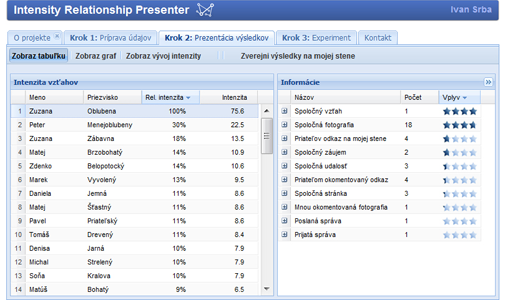|
Tracing Strength of Relationships Ivan Srba Bachelor thesis project supervised by prof. Mária Bieliková |
Motivation
Current web is known as a space with constantly growing interactivity among its users. It is changing from a place for data storage to the social place. Place where people not only search interesting information, but also communicate and collaborate each with other. Obviously, the best and biggest places for common interaction are social networks where people can arrange and explicitly express their relationships. If we know about strong or weak relationship intensity between two users we can provide actions which depend on actual context of deployment. For example we can provide adaptive recommendation. Also the user can control evolution of his or her relationships to friends. If some of these relationships have a tendency to weak, we can notify this user and propose the way how to change current state (e.g., send a message or send some virtual gift).Method
We devised a method for analysis of the evolution of user’s relationships and evaluated it by means of developed web-based application, which approximates the user’s relationships with other users in time. This approximation is based on varied user’s activities performed in social networks. Example of this activity is sending a message or uploading common photography. Such activity we denote as a rate factor. Partial intensity expressed by one rate factor depends on rate factor’s weight, the count of all appearances of the rate factor and for some types of activities also on time when activity happens and the duration of influence. All this effects are included in sequence of calculation.
Evaluation
We can use many sources of user’s activities to evaluate proposed method. We chose for the experiment well known and popular social portal Facebook. We developed software tool named IRe to realize the proposed method. This application uses a wrapper to connect to social network Facebook and to data mine rate factors via Facebook API.
In the experiment we achieved three results. First one is that the method calculated relationship intensity for first ten best friends with 88% precision. Second one is that the calculated intensity described similar distribution of user interaction among friends as in related works. Finally, third achieved result is that the calculated intensity represented similar evolution of relationships in time as it was described in other researches.

Publications
- Srba, I.
- Tracing strength of relationships between users in social networks. Bachelor thesis, Slovak University of Technology in Bratislava 2010. 35p.
 pdf (in Slovak)
pdf (in Slovak)
- Srba, I.
- Tracing Strength of Relationships in Social Networks. In Proc. in Informatics and Information Technology Student Research Conference IIT.SRC 2010.
- Srba, I., Bieliková, M.
- Tracing Strength of Relationships in Social Networks. 2010 IEEE/WIC/ACM Int. Conf. on Web Intelligence and Intelligent Agent Technology. IEEE Computer Society. Vol. 3, pp.13-16.
| to Homepage | to Teaching | to the Top |
|
||
|
||